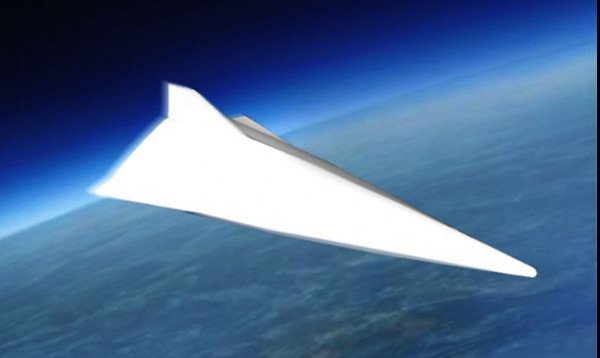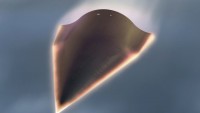Russia and China Claim to be Ahead of US in Developing Hypersonic Missiles
| Arthur Dominic Villasanta | | May 07, 2017 08:48 AM EDT |
Chinese hypersonic glide vehicle
Russia and China simultaneously claim they're both ahead of the United States in the development of hypersonic missiles despite the absence of convincing proof to back-up their claims made through their respective state-controlled media outlets.
The U.S., China and Russia are engaged in a deadly "hypersonic arms race" to develop operational hypersonic glide vehicles (HGVs) armed with either conventional high-explosive or nuclear warheads.
Like Us on Facebook
HGVs travel at hypersonic speeds (or speeds from Mach 5 to Mach 10 or 6,200 km/h to 12,340 km/h) and these fantastic speeds make them virtually immune to interception by modern surface-to-air missiles and anti-ballistic missiles.
Russian scientists have now surpassed U.S. scientists in hypersonic speed advances, alleges Vasily Fomin, Director of the Russian Academy of Sciences' Siberian Branch, without offering proof to back-up this claim.
"The results are better than those of the U.S.," said Fomin.
On April 20, Deputy Prime Minister Dmitry Rogozin boasted Russia was developing hypersonic weapons at par with the United States.
Russia's Ministry of Defense a few years ago said it plans to deploy hypersonic missile and other advanced weapons by 2025 within the framework of the 2018-2025 State Armaments Program.
Russia, however, is still frantically searching for new materials to protect the hypersonic missiles from being destroyed by the superheated plasma cocoon created by their flight.
Russia has made hypersonic weapons a defense priority, especially with the opening of NATO's first defensive missile shield in Romania. When completed, NATO's missile defense system will extend from Greenland in the far north of Europe to the Azores Islands in the south. Another missile defense system will become operational in Poland by 2018.
Russian Deputy Defense Minister Yuri Borisov said Russia is searching for new materials to develop its hypersonic weapons.
"Coming next are hypersonic weapons, which require the use of principally new materials and control systems that operate in a completely different medium, in plasma," said Borisov.
Borisov's remarks seem to indicate Russia's hypersonic weapons development program has run into trouble after announcing in August 2016 that its Yu-74 HGV is ready for war. The new ICBM intended to carry Yu-74 won't be ready until 2020 at the earliest, however.
On the other hand, China's state-controlled media says Chinese scientists will test a prototype combined-cycle hypersonic engine later this year. If successful, the engine might be the first of its type in the world to power a hypersonic vehicle or the first stage of a two-stage-to-orbit spaceplane.
This announcement is at odds with news released last month that confirms Chinese scientists will be unable to deploy a hypersonic boost and glide missile by 2020 and hypersonic missiles propelled by scramjets by 2025.
Chinese state-owned media reported that China will test a prototype combined-cycle hypersonic engine -- one of the proposed propulsion systems for an HGV -- later this year. If successful, this test might lead to the first demonstration flight of a full-scale scramjet propulsion system by 2025.
TagsRussia, china, United States, hypersonic missiles, hypersonic arms race, hypersonic glide vehicles, HGVs, Vasily Fomin
©2015 Chinatopix All rights reserved. Do not reproduce without permission
EDITOR'S PICKS
-

Did the Trump administration just announce plans for a trade war with ‘hostile’ China and Russia?
-

US Senate passes Taiwan travel bill slammed by China
-

As Yan Sihong’s family grieves, here are other Chinese students who went missing abroad. Some have never been found
-

Beijing blasts Western critics who ‘smear China’ with the term sharp power
-

China Envoy Seeks to Defuse Tensions With U.S. as a Trade War Brews
-

Singapore's Deputy PM Provides Bitcoin Vote of Confidence Amid China's Blanket Bans
-

China warns investors over risks in overseas virtual currency trading
-

Chinese government most trustworthy: survey
-

Kashima Antlers On Course For Back-To-Back Titles
MOST POPULAR
LATEST NEWS
Zhou Yongkang: China's Former Security Chief Sentenced to Life in Prison

China's former Chief of the Ministry of Public Security, Zhou Yongkang, has been given a life sentence after he was found guilty of abusing his office, bribery and deliberately ... Full Article
TRENDING STORY

China Pork Prices Expected to Stabilize As The Supplies Recover

Elephone P9000 Smartphone is now on Sale on Amazon India

There's a Big Chance Cliffhangers Won't Still Be Resolved When Grey's Anatomy Season 13 Returns

Supreme Court Ruled on Samsung vs Apple Dispute for Patent Infringement

Microsoft Surface Pro 5 Rumors and Release Date: What is the Latest?












